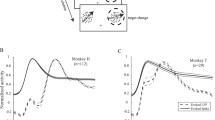Summary
EMG potentials were recorded simultaneously with spontaneous intracellular multifocus slow potentials in the rabbit superior rectus under general anesthesia. Those EMG potentials which were synchronous with such intracellular potentials, are essentially monophasic and at least 4 msec in duration, clearly different from spike potentials. It was verified, that the fibers which produce such spontaneous intracellular multifocus slow potentials are indeed multiply innervated. The study of such slow potential activity in human extraocular muscles may be profitable.
Résumé
Sur le muscle droit supérieur du lapin anesthésié on a enregistré simultanément des potentiels EMG et des potentiels intracellulaires lents prenant naissance dans des foyers cellulaires multiples. Quelques enregistrements ont montré l'apparition synchrone de potentiels EMG et de potentiels intracellulaires lents ‘multi-foyers’; dans tous ces cas les potentiels EMG étaient essentiellement monophasiques et d'une durée supérieure à 4 msec, présentant ainsi des caractéristiques différentes de celles d'un potentiel de pointe propagé. Il a pu être vérifié que les fibres musculaires qui donnent naissance aux potentiels intracellulaires lents multifoyers, sont des fibres à innervation multiple. L'étude des potentiels lents chez l'homme pourrait être intéressante.
Zusammenfassung
Im Rectus superior des Kaninchens wurden in Narkose gleichzeitig EMG Potentiale und spontane langsame, intracelluläre multifokale Potentiale registriert. Die EMG Potentiale, die mit den intracellulären Potentialen synchron auftreten, sind hauptsächlich monophasisch, sie dauern wenigstens 4 msec und unterscheiden sich deutlich von den ‘Spike’-Potentialen. Es hat sich bestätigt, daß die Fasern, welche solche spontanen, intracellulären, multifokalen langsamen Potentiale hervorrufen, tatsächlich eine mehrfache Innervation besitzen. Es wäre interessant, auch beim Menschen diese langsamen Potentiale zu untersuchen.
Similar content being viewed by others
References
Adler, F. H. Physiology of the Eye. Saint Louis: C. V. Mosby Co. (1965).
Bach-Y-Rita, P. Neurophysiology of extraocular muscles.Invest. Ophthal. 6,229–234 (1967).
Ginsborg, B. L. Some properties of avian skeletal muscle fibres with multiple neuromuscular junctions.J. Physiol. 154,581–598 (1960).
Karnovski, M. J. The localization of cholinesterase activity in rat cardiac muscle by electron microscopy.J. cell. Biol. 23,217–222 (1964).
Matyushkin, D. P. Motor innervation of tonic muscle fibres of the oculomotorsystem.Fed. Proc. (Transl. Suppl.) 22,728–731 (1963).
— Motor systems in the oculomotor apparatus of higher animals.Fed. Proc. (Trans. Suppl.) 23,1103–1106 (1964).
Nemet, P. &J. E. Miller. Evoked potentials in cat extraocular muscle.Invest. Ophthal. 7,592–598 (1968).
Ozawa, T. Some electrophysiological properties of rabbit extraocular muscle recorded in vivo with intracellular electrode.Jap. J. Ophthal. 8,111–116 (1964).
— Multiple innervation in rabbit extraocular muscle fibres.Acta Soc. ophthal. jap. 69,1064–1068 (1965).
Ozawa, T. K. Cheng-Minoda, J. Davidowitz & G. M. Breinin. Multi-innervated twitch fibres in extraocular muscle: Staining with recording microelectrode (submitted toScience).
Peachey, L. D. Muscle.Am. Rev. Physiol 30,401–440 (1968).
Thomas, R. C. &V. J. Wilson. Marking single neurons by staining with intracellular recording microelectrodes.Science, 151,1538–1539 (1966).
Author information
Authors and Affiliations
Additional information
Supported by research grant NB 00911-12A1 From N. I. H. and by postdoctoral research fellowship awards from the National Council to Combat Blindness, Inc. No. TF-173 (C4) to Tetsuma Ozawa and No. F 180 to Kensei Cheng.
Rights and permissions
About this article
Cite this article
Ozawa, T., Cheng-Minoda, K., Davidowitz, J. et al. Correlation of potential and fiber type in extraocular muscle. Doc Ophthalmol 26, 192–201 (1969). https://doi.org/10.1007/BF00943976
Published:
Issue Date:
DOI: https://doi.org/10.1007/BF00943976




